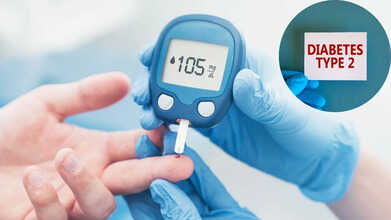- Health Conditions A-Z
- Health & Wellness
- Nutrition
- Fitness
- Health News
- Ayurveda
- Videos
- Medicine A-Z
- Parenting
- Web Stories
Do You Have Persistent Nasal Congestion? It Could Be A Sign of Long Covid

Credits: Canva
A symptom that most people associate with a common cold could actually indicate long Covid. Typically, individuals recover from a coronavirus infection within a few weeks after symptoms begin. However, NHS guidance points out that some people can develop a more persistent illness, with symptoms lasting far longer.
Long Covid, also called post-COVID syndrome, is usually diagnosed when COVID-19 symptoms persist for more than 12 weeks. Keep reading to learn which common symptom might actually be a sign of long Covid.
One Nose Symptom That Can Also Be Long Covid
Long Covid symptoms can vary widely, and many may be mistaken for a regular cold or flu. For instance, a sore throat or a runny nose could suggest either a common cold or long Covid, depending on how long the symptom has been present.
What Are Common Symptoms Of Long Covid
Other symptoms may include:
- Memory or concentration difficulties, often referred to as brain fog
- Shortness of breath
- Joint aches and muscle pain
- Extreme fatigue
- Hair loss or skin rashes such as hives
- Nasal congestion or a runny nose
- Headaches, dizziness, or vertigo
- Pins and needles or widespread body aches
- Persistent cough
- Abdominal pain or diarrhoea
- Nausea, vomiting, weight loss, and reduced appetite
- Trouble sleeping (insomnia)
- Elevated temperature
- Changes in senses, including vision issues, earaches, tinnitus, or altered taste and smell
- Anxiety and depression
- Sore throat
- Sudden confusion (delirium), especially in older adults
- Chest pain or tightness, and noticeable heart palpitations
How To Know If You Have Long Covid Or Common Cold?
Telling the difference between a common cold and COVID-19 can be tricky, as many symptoms overlap. You can look for clues such as when the symptoms started, the intensity of fatigue, and whether you have experienced loss of taste or smell, a hallmark of earlier COVID variants. The only way to be sure is to take a COVID-19 test.
Long Covid stands apart from both a cold and acute COVID-19 because its symptoms, like fatigue, shortness of breath, and cognitive difficulties, persist for weeks or months after the initial infection.
Long Covid Complications
Some people, particularly those who had severe COVID-19, may experience effects on multiple organs or develop autoimmune conditions lasting weeks, months, or even years. These multi-organ effects can involve the heart, lungs, kidneys, skin, and brain. Many of these complications share symptoms with commonly reported long Covid issues. Consequently, people who have had COVID-19 may be at higher risk of developing or worsening conditions such as:
- Diabetes
- Heart problems
- Blood clots
- Neurological disorders
If you suspect you have long Covid, your GP may run several tests to rule out other causes of your symptoms, including blood tests. They might also monitor your heart rate and oxygen levels.
In some cases, further investigations such as an ECG or X-ray may be required. Some patients may be referred to a team of specialists at a post-COVID syndrome clinic for comprehensive evaluation.
This FDA-Approved Drug Combo Could Reduce Risk Of Prostate Cancer Deaths By 40%

(Credit-Canva)
Prostate cancer is one of the most common cancers in men. About 1 in 8 men are at risk of prostate cancer diagnosis and about 1 in 44 men die due to it, according to the American Cancer Society. While the rates of deaths related to prostate cancer have declined in recent years, this decline rate has slowed down, meaning that more cancers are being detected at an advanced stage.
However, a new clinical trial could help turn these statistics around. This is not a new medicine, this treatment regime is based on two FDA-approved drugs, and it is showing some promising results.
A new clinical trial shows that a combination of two drugs can dramatically help men whose prostate cancer has returned following surgery or radiation. This new therapy was found to cut the risk of death by more than 40% in this high-risk group.
The successful regimen combines the drug enzalutamide with the standard hormone therapy doctors typically prescribe. This dual approach resulted in a major reduction in deaths for patients with recurrent prostate cancer who previously had very few effective treatment options left.
The highly anticipated results were published in The New England Journal of Medicine (NEJM) and presented simultaneously at the European Society for Medical Oncology Congress (ESMO) on October 19.
Why Is Prostate Cancer Considered High Risk?
The American Cancer Society estimates for 2025 are about 313,780 new cases of prostate cancer diagnosis and 35,770 deaths from it. One of the best ways to combat cancer is early diagnosis, however, missing symptoms is very easy. With the help of this medicinal regime, many people can avoid facing harsh cancer treatments.
The clinical trial was extensive, involving over 1,000 patients from hundreds of medical facilities across 17 different countries. All of the men were diagnosed with a condition known as high-risk biochemically recurrent prostate cancer.
This specific diagnosis is given to men whose blood levels of a protein called PSA (Prostate Specific Antigen) suddenly start to climb rapidly after they've had surgery or radiation. Doctors use the PSA protein to track the cancer, and a quick rise is a strong signal that the cancer is highly likely to come back and spread to other areas, most often the bones or spine. Without a truly powerful treatment, these patients face a high risk of developing widespread cancer and possibly dying from their disease.
What Medicine Can Reduce the Risk Of Prostate Cancer?
In the study, the men were randomly put into three groups: one group got only the standard hormone therapy, one got only enzalutamide, and the third got the combination of both drugs. After the men were tracked for eight years, the group that received the combination treatment had a death rate that was 40.3% lower than the other two groups.
These excellent results are expected to quickly change the way doctors treat this type of cancer everywhere. The drug enzalutamide is already approved by government agencies and listed in major cancer treatment guidelines based on previous studies.
These latest results will likely make the recommendation even stronger, confirming that this drug combination should become the standard treatment for men with this aggressive, recurrent prostate cancer. This outcome supports earlier research and will significantly improve how doctors care for their patients.
Symptoms of Prostate Cancer You Should Know.
While researchers are working on ways to improve prostate cancer treatment, one must know how to spot any symptoms of it as well. According to the National Health Service UK, prostate cancer has no symptoms at first. However, as the cancer starts growing on the outer parts of the prostate, you may notice some problems.
- Having a hard time getting your urine flow to start, or needing to push or strain to get the urine out.
- When you do urinate, the flow is much weaker than usual.
- Your stream stops and starts multiple times while you're trying to empty your bladder.
- Suddenly seeing a rise in the urgency and frequency of needing to urinate, than what you usually feel.
- Feeling like your bladder isn't completely empty, even right after you finish urinating.
- Waking up many times during the night because you need to urinate.
Some symptoms of advanced prostate cancer include
- Erectile dysfunction
- Blood in your urine or semen
- Lower back pain and unexpected weight loss.
Blood Sugar Levels In Type 2 Diabetes: What Counts As High, Low, Or Normal?

Credits: Canva
Type 2 diabetes is a long-term condition where your body either doesn’t produce enough insulin or can’t use the insulin it makes properly, causing blood sugar levels to rise. Keeping an eye on your blood sugar is essential for managing the condition and protecting your overall health.
A blood sugar chart can help you understand what’s normal, too high, or too low. By getting familiar with these ranges, you can work with your doctor to maintain healthy levels and reduce the risk of complications. Below, we break down everything you need to know about type 2 diabetes.
What is Type 2 diabetes?
Type 2 diabetes (T2D) occurs when blood sugar (glucose) remains consistently high. Normal blood sugar levels fall between 70 and 99 milligrams per deciliter (mg/dL). If undiagnosed, Type 2 diabetes often shows levels of 126 mg/dL or more.
T2D happens because the pancreas doesn’t produce enough insulin, the body can’t use insulin effectively, or a combination of both. This differs from Type 1 diabetes, which arises when the immune system attacks the pancreas, leaving the body unable to produce insulin at all.
How Common Is Type 2 Diabetes?
Type 2 diabetes is widespread. Over 37 million people in the U.S. have diabetes (around 1 in 10), with 90–95% of cases being T2D. Globally, it affects roughly 6.3% of the population. While it’s most common in adults over 45, younger adults and even children can develop it.
Blood Sugar Range For Adults With Type 2 Diabetes And Children With Type 2 Diabetes
The American Diabetes Association recommends the following ranges for adults with type 1 or type 2 diabetes and children with type 2 diabetes:
| Time | Recommended Blood Sugar Range |
| Fasting (before eating) | 80 to 130 mg/dL |
| 1 to 2 hours after meal | Lower than 180 mg/dL |
Is Type 2 Diabetes Genetic?
T2D has complex causes, but genes play a significant role. If one biological parent has T2D, your lifetime risk is around 40%, and if both parents do, it rises to 70%. Scientists have identified over 150 DNA variations linked to T2D risk, some increase the chance of insulin resistance or reduced insulin production, while others influence obesity risk. These genetic factors interact with lifestyle and health habits to determine overall risk.
How is Type 2 Diabetes Diagnosed?
Doctors use several blood tests to confirm T2D:
- Fasting plasma glucose test: Measures blood sugar after an eight-hour fast. A result of 126 mg/dL or higher indicates diabetes.
- Random plasma glucose test: Measures blood sugar at any time without fasting. A reading of 200 mg/dL or higher signals diabetes.
- A1C test: Reflects average blood sugar over the past 2–3 months. A level of 6.5% or higher indicates diabetes.
What Is A1C?
A1C shows your average blood sugar for the past three months. When sugar circulates in your blood, it attaches to a protein called hemoglobin. Higher blood sugar levels result in a higher percentage of hemoglobin coated with sugar. Your A1C result helps indicate whether your blood sugar is normal, prediabetic, or diabetic.
The chart below shows where your A1C result stands, whether it is within a healthy range or could indicate prediabetes or diabetes.
| Diagnosis | AIC Result |
| Normal | less than 5.7% |
| Prediabetes | between 5.7% and 6.4% |
| Diabetes | 6.5% and higher |
Not All Antidepressants Affect Your Body The Same; Here’s What You Need To Know About Side Effects

Credits: Canva
Antidepressants side effects: Anyone who has been prescribed medication for depression knows the long list of possible side effects: fatigue, appetite changes, headaches, and more. But these physical reactions are not the same across all medications. Recent research shows that some antidepressants can cause quick changes in weight, heart rate, and blood pressure, while others are relatively mild. The purpose of this work was to rank antidepressants based on their known side effects, specifically those that appear within the first eight weeks of starting treatment.
What Are Antidepressants?
Antidepressants are prescription medications used to treat conditions like depression, anxiety, chronic pain, and more by boosting brain chemicals that regulate mood. Common types include SSRIs, SNRIs, and NDRIs. They often take several weeks to show full effect. Typical side effects can include dry mouth, weight changes, and dizziness. Interestingly, new research suggests that the side effect profile can vary depending on the specific antidepressant.
Also Read: Why Do I Get Bad Dreams When I Am Sick?
Types of Antidepressants
There are several categories of antidepressant medications, as per NHS:
- Selective serotonin reuptake inhibitors (SSRIs): Increase serotonin levels in the brain to improve mood.
- Serotonin-norepinephrine reuptake inhibitors (SNRIs): Raise both serotonin and norepinephrine, helping with mood, alertness, and stress.
- Tricyclic antidepressants: Affect serotonin and norepinephrine like SNRIs, but also influence other parts of the body and brain.
- Monoamine oxidase inhibitors (MAOIs): Boost brain chemical levels by blocking an enzyme that breaks them down.
- NMDA receptor antagonists: Work quickly to improve mood by targeting specific brain receptors, usually given in clinics if other medications fail.
- Atypical antidepressants: Don’t fit neatly into other groups, each affecting brain chemicals in unique ways.
Physical Side Effects Differ Across Antidepressants
Millions of adults in the U.S. rely on antidepressants for conditions such as depression and anxiety. Like all medications, these drugs can cause side effects, though the severity varies. Researchers from King’s College London and the University of Oxford examined just how differently side effects appear across 30 antidepressants, analyzing data from over 58,500 participants in more than 150 studies.
“Not all antidepressants are the same when it comes to their physical side effects,” explained Toby Pillinger, an academic clinical lecturer at King’s College London. The findings, published in The Lancet, are the first to link specific physical side effects to individual antidepressants, offering potentially important guidance for doctors prescribing these medications, which are taken by up to 17% of adults in Europe and North America.
Drugs reviewed included SSRIs like sertraline (Zoloft) and fluoxetine (Prozac), SNRIs like duloxetine (Cymbalta) and venlafaxine (Effexor), and NDRIs like bupropion (Wellbutrin).
Antidepressants Side Effects
The research looked at 30 commonly prescribed antidepressants across 151 studies involving over 58,500 patients. Not everyone develops side effects, but on average:
- Eight weeks of agomelatine use linked to a 2.4kg weight loss, whereas maprotiline led to nearly 2kg weight gain.
- Heart rate varied by 21 beats per minute between fluvoxamine, which slowed the heart, and nortriptyline, which sped it up.
- Blood pressure differed by 11 mmHg between nortriptyline and doxepin.
Antidepressants: Effects on Heart Rate and Blood Pressure
Some medications, like fluoxetine, were linked to increased systolic blood pressure, while others, like citalopram (Celexa), were not. Citalopram was associated with slight weight loss, decreased heart rate, and systolic blood pressure, with a minor rise in diastolic blood pressure. Venlafaxine raised heart rate, while paroxetine (Paxil) caused no heart rate changes.
“Clearly, no two antidepressants affect the body in the same way,” said Dr. Atheeshaan Arumuham from King’s College London.
Interestingly, commonly prescribed antidepressants in the U.S., such as fluoxetine, bupropion, and sertraline, were linked to weight loss over the short-term in these trials. For reference, about 1.4 million people were prescribed citalopram last year.
Antidepressants: Short-Term or Long-Term Side Effects?
A limitation of this research is that the studies analyzed were relatively short, with a median treatment duration much shorter than most real-world use. It also did not assess other common side effects, including sexual dysfunction, headaches, upset stomach, and, in rare cases, agitation or suicidal thoughts. Since the focus was on the first eight weeks, further research is needed to understand long-term effects.
Choosing the Right Antidepressant
As side effects differ across medications, there is no one-size-fits-all solution. Dr. Pillinger advises that selecting the right antidepressant should always be done in consultation with a qualified medical professional.
© 2024 Bennett, Coleman & Company Limited

